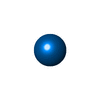[English] 日本語
 Yorodumi
Yorodumi- PDB-1b4h: OLIGO-PEPTIDE BINDING PROTEIN COMPLEXED WITH LYSYL-DIAMINOBUTYRIC... -
+ Open data
Open data
- Basic information
Basic information
| Entry | Database: PDB / ID: 1b4h | ||||||
|---|---|---|---|---|---|---|---|
| Title | OLIGO-PEPTIDE BINDING PROTEIN COMPLEXED WITH LYSYL-DIAMINOBUTYRIC ACID-LYSINE | ||||||
 Components Components |
| ||||||
 Keywords Keywords | PEPTIDE BINDING PROTEIN / PERIPLASMIC PEPTIDE BINDING PROTEIN | ||||||
| Function / homology |  Function and homology information Function and homology informationpeptide transport / peptide transmembrane transporter activity / ATP-binding cassette (ABC) transporter complex / protein transport / outer membrane-bounded periplasmic space Similarity search - Function | ||||||
| Biological species |  Salmonella typhimurium (bacteria) Salmonella typhimurium (bacteria) | ||||||
| Method |  X-RAY DIFFRACTION / OTHER / Resolution: 1.9 Å X-RAY DIFFRACTION / OTHER / Resolution: 1.9 Å | ||||||
 Authors Authors | Davies, T.G. / Tame, J.R.H. | ||||||
 Citation Citation |  Journal: Protein Sci. / Year: 1999 Journal: Protein Sci. / Year: 1999Title: Relating structure to thermodynamics: the crystal structures and binding affinity of eight OppA-peptide complexes. Authors: Davies, T.G. / Hubbard, R.E. / Tame, J.R. #1:  Journal: Structure / Year: 1995 Journal: Structure / Year: 1995Title: The Crystal Structures of the Oligopeptide-Binding Protein Oppa Complexed with Tripeptide and Tetrapeptide Ligands Authors: Tame, J.R. / Dodson, E.J. / Murshudov, G. / Higgins, C.F. / Wilkinson, A.J. | ||||||
| History |
|
- Structure visualization
Structure visualization
| Structure viewer | Molecule:  Molmil Molmil Jmol/JSmol Jmol/JSmol |
|---|
- Downloads & links
Downloads & links
- Download
Download
| PDBx/mmCIF format |  1b4h.cif.gz 1b4h.cif.gz | 123.4 KB | Display |  PDBx/mmCIF format PDBx/mmCIF format |
|---|---|---|---|---|
| PDB format |  pdb1b4h.ent.gz pdb1b4h.ent.gz | 94.4 KB | Display |  PDB format PDB format |
| PDBx/mmJSON format |  1b4h.json.gz 1b4h.json.gz | Tree view |  PDBx/mmJSON format PDBx/mmJSON format | |
| Others |  Other downloads Other downloads |
-Validation report
| Summary document |  1b4h_validation.pdf.gz 1b4h_validation.pdf.gz | 376.1 KB | Display |  wwPDB validaton report wwPDB validaton report |
|---|---|---|---|---|
| Full document |  1b4h_full_validation.pdf.gz 1b4h_full_validation.pdf.gz | 382 KB | Display | |
| Data in XML |  1b4h_validation.xml.gz 1b4h_validation.xml.gz | 12 KB | Display | |
| Data in CIF |  1b4h_validation.cif.gz 1b4h_validation.cif.gz | 20 KB | Display | |
| Arichive directory |  https://data.pdbj.org/pub/pdb/validation_reports/b4/1b4h https://data.pdbj.org/pub/pdb/validation_reports/b4/1b4h ftp://data.pdbj.org/pub/pdb/validation_reports/b4/1b4h ftp://data.pdbj.org/pub/pdb/validation_reports/b4/1b4h | HTTPS FTP |
-Related structure data
| Related structure data | 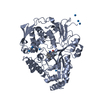 1b0hC 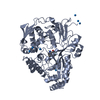 1b1hC 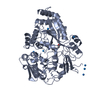 1b2hC 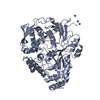 1b3hC 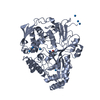 1b5hC 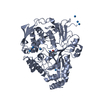 1b6hC 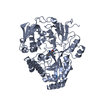 1b7hC C: citing same article ( |
|---|---|
| Similar structure data |
- Links
Links
- Assembly
Assembly
| Deposited unit | 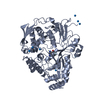
| ||||||||||
|---|---|---|---|---|---|---|---|---|---|---|---|
| 1 |
| ||||||||||
| Unit cell |
|
- Components
Components
| #1: Protein | Mass: 58878.984 Da / Num. of mol.: 1 Source method: isolated from a genetically manipulated source Source: (gene. exp.)  Salmonella typhimurium (bacteria) / Production host: Salmonella typhimurium (bacteria) / Production host:  | ||||||
|---|---|---|---|---|---|---|---|
| #2: Protein/peptide | Mass: 376.494 Da / Num. of mol.: 1 / Source method: obtained synthetically | ||||||
| #3: Chemical | ChemComp-U1 / #4: Water | ChemComp-HOH / | Has protein modification | Y | Nonpolymer details | THE SOLVENT STRUCTURE AROUND THE URANIUM IONS IS TENTATIVE | |
-Experimental details
-Experiment
| Experiment | Method:  X-RAY DIFFRACTION / Number of used crystals: 1 X-RAY DIFFRACTION / Number of used crystals: 1 |
|---|
- Sample preparation
Sample preparation
| Crystal | Density Matthews: 2.47 Å3/Da / Density % sol: 50.3 % | |||||||||||||||||||||||||
|---|---|---|---|---|---|---|---|---|---|---|---|---|---|---|---|---|---|---|---|---|---|---|---|---|---|---|
| Crystal grow | pH: 5.5 / Details: pH 5.5 | |||||||||||||||||||||||||
| Crystal grow | *PLUS Method: vapor diffusion, hanging drop | |||||||||||||||||||||||||
| Components of the solutions | *PLUS
|
-Data collection
| Diffraction | Mean temperature: 120 K |
|---|---|
| Diffraction source | Source:  ROTATING ANODE / Wavelength: 1.5418 ROTATING ANODE / Wavelength: 1.5418 |
| Radiation | Protocol: SINGLE WAVELENGTH / Monochromatic (M) / Laue (L): M / Scattering type: x-ray |
| Radiation wavelength | Wavelength: 1.5418 Å / Relative weight: 1 |
| Reflection | Resolution: 1.9→20 Å / Num. obs: 47784 / % possible obs: 99.8 % / Redundancy: 4.6 % / Rmerge(I) obs: 0.11 / Net I/σ(I): 5.3 |
| Reflection | *PLUS Highest resolution: 1.9 Å / Lowest resolution: 20 Å / Num. obs: 47784 / % possible obs: 98.7 % / Num. measured all: 221800 / Rmerge(I) obs: 0.11 |
| Reflection shell | *PLUS % possible obs: 99.2 % / Rmerge(I) obs: 0.31 / Mean I/σ(I) obs: 2.4 |
- Processing
Processing
| Software |
| ||||||||||||||||||||||||||||||||||||||||||||||||||||||||||||||||||||||||||||||||||||
|---|---|---|---|---|---|---|---|---|---|---|---|---|---|---|---|---|---|---|---|---|---|---|---|---|---|---|---|---|---|---|---|---|---|---|---|---|---|---|---|---|---|---|---|---|---|---|---|---|---|---|---|---|---|---|---|---|---|---|---|---|---|---|---|---|---|---|---|---|---|---|---|---|---|---|---|---|---|---|---|---|---|---|---|---|---|
| Refinement | Method to determine structure: OTHER / Resolution: 1.9→20 Å / Cross valid method: THROUGHOUT / σ(F): 0
| ||||||||||||||||||||||||||||||||||||||||||||||||||||||||||||||||||||||||||||||||||||
| Displacement parameters | Biso mean: 19.5 Å2 | ||||||||||||||||||||||||||||||||||||||||||||||||||||||||||||||||||||||||||||||||||||
| Refinement step | Cycle: LAST / Resolution: 1.9→20 Å
| ||||||||||||||||||||||||||||||||||||||||||||||||||||||||||||||||||||||||||||||||||||
| Refine LS restraints |
| ||||||||||||||||||||||||||||||||||||||||||||||||||||||||||||||||||||||||||||||||||||
| Software | *PLUS Name: REFMAC / Classification: refinement | ||||||||||||||||||||||||||||||||||||||||||||||||||||||||||||||||||||||||||||||||||||
| Refinement | *PLUS Rfactor Rfree: 0.23 / Rfactor Rwork: 0.19 / Highest resolution: 1.9 Å / Lowest resolution: 20 Å / σ(F): 0 / % reflection Rfree: 5 % / Rfactor obs: 0.192 | ||||||||||||||||||||||||||||||||||||||||||||||||||||||||||||||||||||||||||||||||||||
| Solvent computation | *PLUS | ||||||||||||||||||||||||||||||||||||||||||||||||||||||||||||||||||||||||||||||||||||
| Displacement parameters | *PLUS Biso mean: 19.5 Å2 | ||||||||||||||||||||||||||||||||||||||||||||||||||||||||||||||||||||||||||||||||||||
| Refine LS restraints | *PLUS
|
 Movie
Movie Controller
Controller



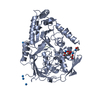
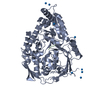
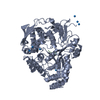
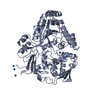
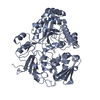

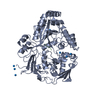

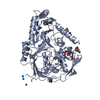




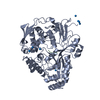
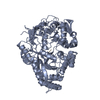
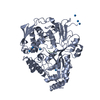
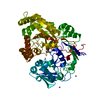
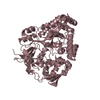
 PDBj
PDBj